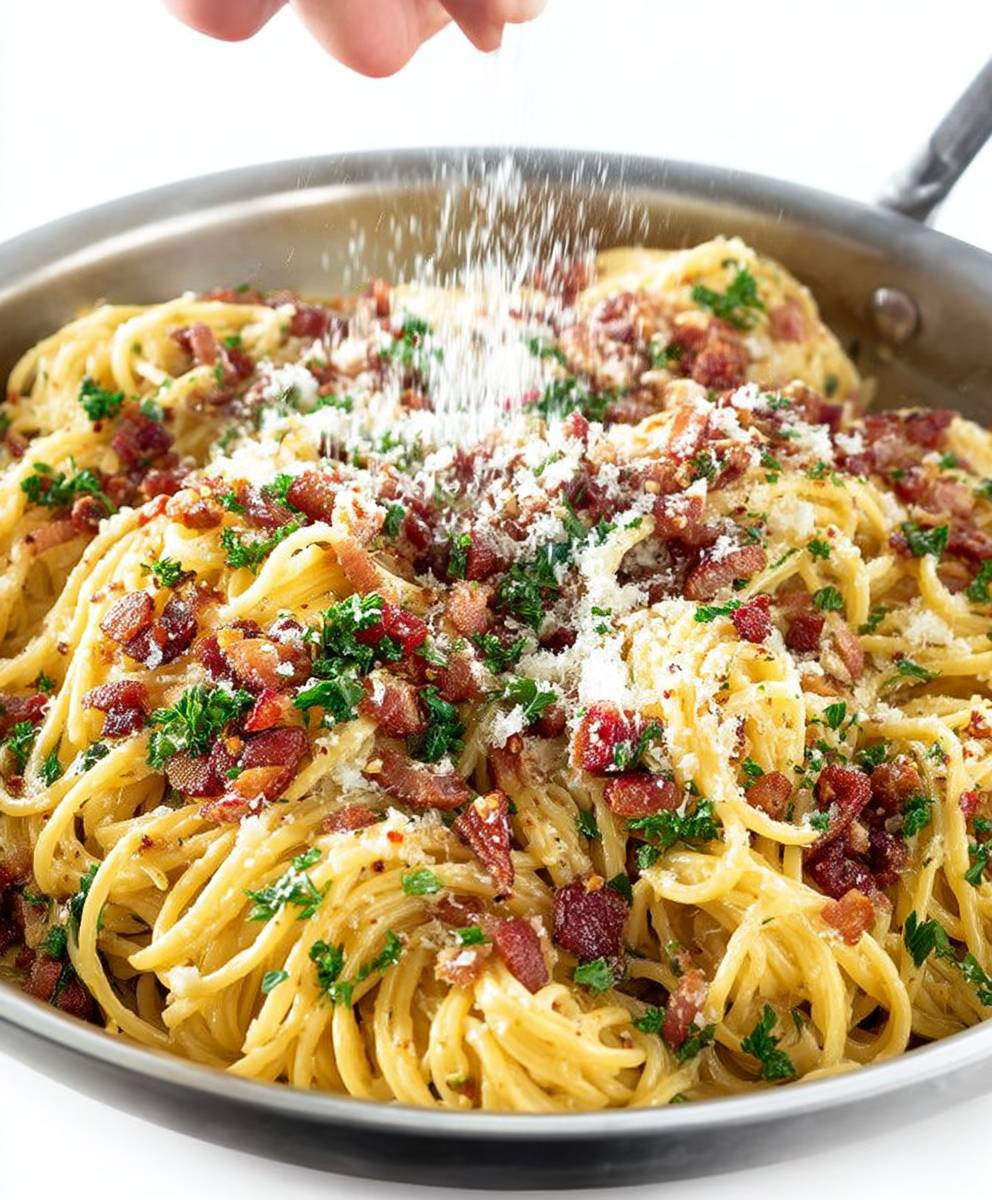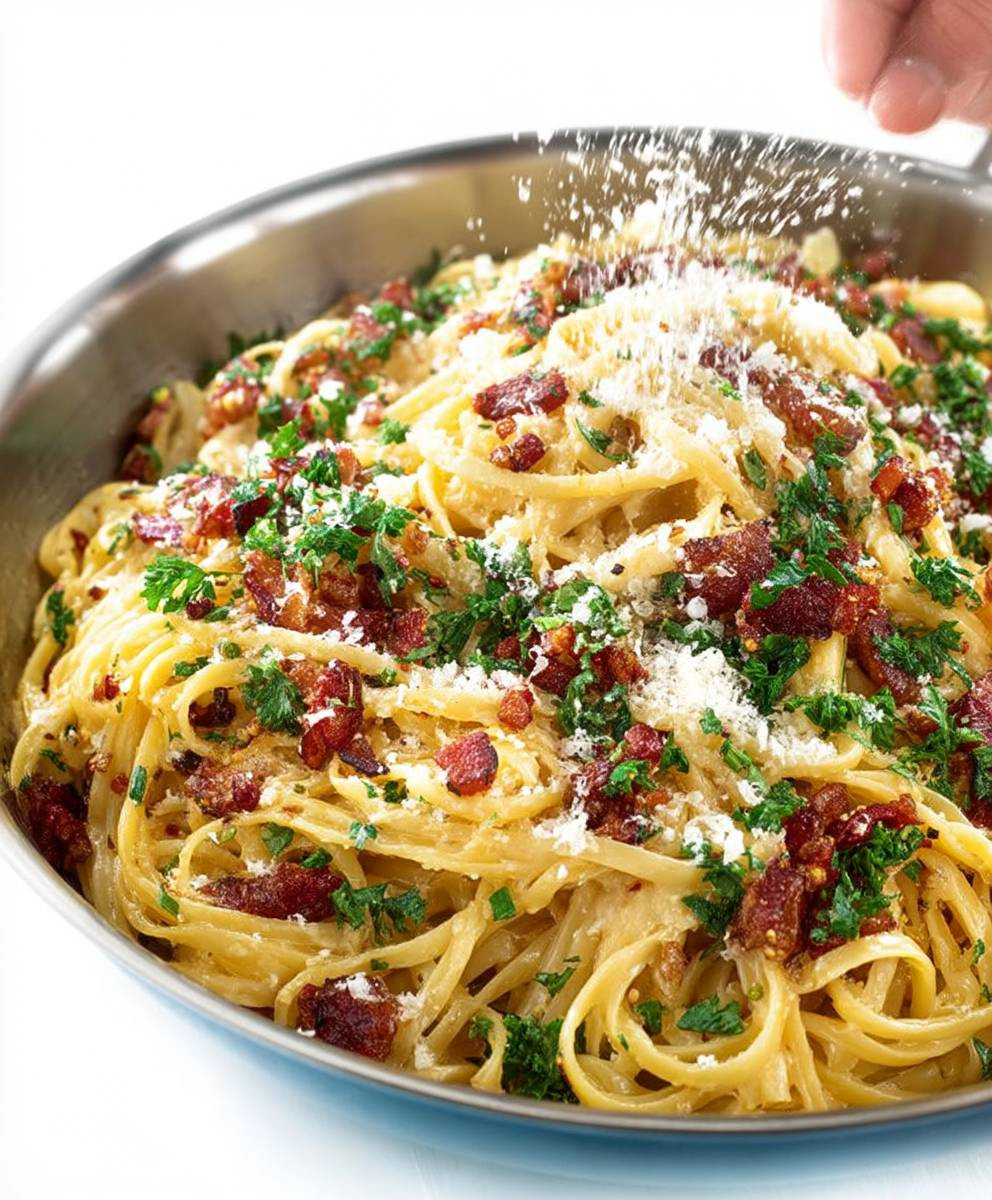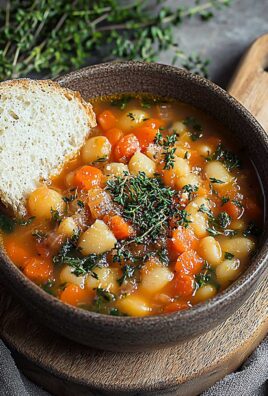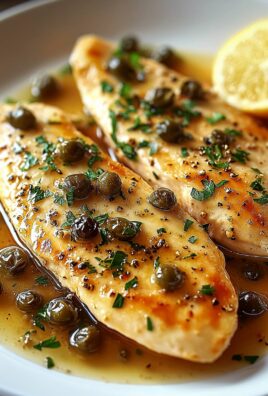Pasta Carbonara: just the name conjures up images of creamy, decadent comfort food, doesn’t it? Forget complicated sauces and hours in the kitchen; this classic Italian dish is surprisingly simple to make, yet delivers an explosion of flavor that will have you craving more. Have you ever wondered how such a seemingly humble combination of ingredients could create such a culinary masterpiece?
While the exact origins of Pasta Carbonara are debated, many believe it emerged in Rome during or after World War II. Some theories suggest it was created to satisfy the appetites of American soldiers who were looking for something familiar yet distinctly Italian. Others say it was a clever way to use readily available ingredients like eggs and bacon rations. Regardless of its true beginnings, Carbonara has become a beloved staple in Italian cuisine and a favorite worldwide.
What makes Pasta Carbonara so irresistible? It’s the perfect marriage of textures and tastes. The rich, creamy sauce, made from eggs, Pecorino Romano cheese, and guanciale (or pancetta), clings beautifully to the perfectly cooked pasta. The salty, savory pork provides a delightful contrast to the smooth, cheesy sauce, creating a symphony of flavors that dance on your palate. Plus, it’s incredibly quick and easy to prepare, making it an ideal weeknight meal. So, let’s dive in and learn how to make authentic Pasta Carbonara that will transport you straight to the heart of Rome!
Ingredients:
- 1 pound spaghetti (or bucatini, if you’re feeling fancy!)
- 6 ounces guanciale (or pancetta, if guanciale is unavailable), cut into 1/4-inch thick lardons
- 4 large eggs
- 1 cup grated Pecorino Romano cheese, plus more for serving
- 1/2 cup grated Parmesan cheese
- Freshly ground black pepper, to taste (and I mean *lots*!)
- Salt, to taste (be careful, the guanciale and cheese are already salty!)
- Optional: 2 cloves garlic, minced (controversial, but I sometimes add it!)
Preparing the Guanciale (or Pancetta):
- First things first, let’s get that guanciale (or pancetta) ready. Place the lardons in a large skillet over medium heat. You want to render the fat slowly, so don’t crank up the heat too high. We’re aiming for crispy, golden-brown pieces of deliciousness.
- Cook the guanciale, stirring occasionally, until it’s crispy and the fat has rendered out. This usually takes about 8-10 minutes. Keep a close eye on it, as it can burn easily. If you’re using pancetta, it might render a bit faster than guanciale.
- Once the guanciale is crispy, remove it from the skillet with a slotted spoon and set it aside on a plate lined with paper towels to drain. Don’t discard the rendered fat! This is liquid gold and we’ll be using it later to coat the pasta.
- If you’re using garlic (and remember, this is optional!), add it to the skillet with the rendered guanciale fat and cook over low heat for about 1 minute, or until fragrant. Be careful not to burn the garlic, as it will become bitter.
- Remove the skillet from the heat and set it aside.
Preparing the Egg and Cheese Mixture:
- While the guanciale is cooking, let’s prepare the egg and cheese mixture. This is the heart and soul of carbonara, so pay attention!
- In a large bowl, whisk together the 4 large eggs. Make sure they’re well combined.
- Add the grated Pecorino Romano cheese and Parmesan cheese to the bowl with the eggs. Use a fork or whisk to thoroughly combine the cheese and eggs. You want a smooth, creamy mixture.
- Season the egg and cheese mixture generously with freshly ground black pepper. I’m talking a *lot* of black pepper. Carbonara is known for its peppery bite. Don’t be shy!
- Set the egg and cheese mixture aside.
Cooking the Pasta:
- Now it’s time to cook the pasta. Bring a large pot of salted water to a rolling boil. Make sure you use enough salt! The pasta water should taste like the sea. This seasons the pasta from the inside out.
- Add the spaghetti to the boiling water and cook according to the package directions, until al dente. “Al dente” means “to the tooth” in Italian, and it refers to pasta that is firm to the bite. You don’t want mushy pasta!
- About 1 minute before the pasta is done, reserve about 1 cup of the pasta water. This starchy water is crucial for creating a creamy sauce.
- Drain the pasta immediately, but do not rinse it! Rinsing removes the starch that helps the sauce cling to the pasta.
Assembling the Carbonara:
- This is where the magic happens! Immediately add the drained pasta to the skillet with the rendered guanciale fat (and garlic, if you used it). Toss the pasta to coat it evenly with the fat.
- Remove the skillet from the heat. This is important! If the skillet is too hot, the eggs will scramble.
- Pour the egg and cheese mixture over the hot pasta. Quickly toss the pasta with the egg and cheese mixture to create a creamy sauce. The heat from the pasta will gently cook the eggs, creating a luscious, velvety texture.
- If the sauce is too thick, add a little of the reserved pasta water, one tablespoon at a time, until it reaches your desired consistency. You want a sauce that coats the pasta without being too runny or too thick.
- Add the crispy guanciale (or pancetta) to the pasta and toss to combine.
- Taste the carbonara and adjust the seasoning as needed. You may need to add more salt or pepper. Remember that the cheese and guanciale are already salty, so be careful not to over-salt.
Serving:
- Serve the carbonara immediately. Carbonara is best enjoyed fresh, as the sauce can thicken as it sits.
- Garnish with extra grated Pecorino Romano cheese and freshly ground black pepper.
- Enjoy your authentic and delicious Pasta Carbonara! Buon appetito!
Tips and Tricks for Perfect Carbonara:
- Use high-quality ingredients. The better the ingredients, the better the carbonara will taste. Splurge on good guanciale, Pecorino Romano cheese, and fresh eggs.
- Don’t overcook the pasta. Al dente pasta is essential for a good carbonara.
- Don’t scramble the eggs. The key to a creamy carbonara sauce is to gently cook the eggs with the heat of the pasta. Remove the skillet from the heat before adding the egg mixture.
- Use reserved pasta water. The starchy pasta water is crucial for creating a creamy sauce.
- Serve immediately. Carbonara is best enjoyed fresh.
- Experiment with variations. While traditional carbonara only contains guanciale, eggs, Pecorino Romano cheese, and black pepper, you can experiment with adding other ingredients, such as garlic, mushrooms, or peas. However, purists will argue that these additions are not authentic.
- Guanciale vs. Pancetta: Guanciale is cured pork cheek, while pancetta is cured pork belly. Guanciale has a richer, more intense flavor than pancetta. If you can find guanciale, it’s definitely worth using. However, pancetta is a perfectly acceptable substitute.
- Pecorino Romano vs. Parmesan: Pecorino Romano is a hard, salty cheese made from sheep’s milk. Parmesan is a hard, granular cheese made from cow’s milk. Pecorino Romano has a sharper, more intense flavor than Parmesan. Traditional carbonara uses Pecorino Romano cheese. However, you can use a combination of Pecorino Romano and Parmesan, as I do in this recipe.
Troubleshooting:
- Sauce is too thick: Add more reserved pasta water, one tablespoon at a time, until it reaches your desired consistency.
- Sauce is too runny: The pasta may not have been hot enough to cook the eggs properly. You can try gently heating the carbonara over low heat, stirring constantly, until the sauce thickens. Be careful not to scramble the eggs.
- Eggs scrambled: The skillet was too hot when you added the egg mixture. Next time, make sure to remove the skillet from the heat before adding the egg mixture.
- Carbonara is too salty: You may have used too much salt in the pasta water or the cheese and guanciale were particularly salty. Next time, use less salt.

Conclusion:
And there you have it! This isn’t just another pasta dish; it’s an experience, a journey to the heart of Italian comfort food. I truly believe this Pasta Carbonara recipe is a must-try for anyone who appreciates simple ingredients transformed into something truly extraordinary. The creamy sauce, the perfectly cooked pasta, the salty guanciale it all comes together in a symphony of flavors that will leave you wanting more.
Why is it a must-try? Because it’s authentic, it’s achievable, and it’s utterly delicious. Forget those heavy, cream-laden imitations you might have encountered. This recipe stays true to the traditional method, relying on the magic of egg yolks, Pecorino Romano cheese, and rendered guanciale fat to create that signature creamy texture. It’s a testament to the power of simplicity, proving that you don’t need a laundry list of ingredients to create a truly memorable meal.
But the best part? It’s incredibly easy to make! Even if you’re a beginner in the kitchen, you can absolutely nail this recipe. The instructions are straightforward, and the cooking time is minimal. In just a few minutes, you can have a restaurant-quality Pasta Carbonara on your table, ready to impress your family and friends.
Now, let’s talk about serving suggestions and variations. While I personally love this recipe in its purest form, there’s always room for a little creativity. For a spicier kick, try adding a pinch of red pepper flakes to the sauce. If you can’t find guanciale, pancetta is a perfectly acceptable substitute, although the flavor profile will be slightly different. For a vegetarian option (although purists might scoff!), you could try using smoked tofu or mushrooms to mimic the smoky, savory flavor of the guanciale.
As for serving, I recommend enjoying this Pasta Carbonara immediately after it’s made, while the sauce is still warm and creamy. A sprinkle of freshly grated Pecorino Romano cheese and a generous grind of black pepper are the perfect finishing touches. Serve it with a simple side salad and a glass of crisp white wine for a complete and satisfying meal. You can also add some grilled chicken or shrimp for extra protein.
Here are a few more ideas to get your creative juices flowing:
Serving Suggestions:
* Serve with a side of crusty bread for soaking up the delicious sauce.
* Garnish with fresh parsley or chives for a pop of color and freshness.
* Pair with a light and refreshing salad, such as a simple arugula salad with lemon vinaigrette.
Variations:
* Add a splash of white wine to the sauce for extra depth of flavor.
* Use different types of pasta, such as bucatini or rigatoni.
* Incorporate vegetables like peas or asparagus for added nutrients and texture.
But honestly, the possibilities are endless! Feel free to experiment and make this recipe your own. The most important thing is to have fun and enjoy the process.
So, what are you waiting for? Grab your ingredients, put on your apron, and get cooking! I’m confident that you’ll love this Pasta Carbonara as much as I do. And when you do, please, please, please come back and share your experience! I’d love to hear your thoughts, your variations, and any tips or tricks you discovered along the way. Let me know in the comments below how it turned out for you. Did you make any substitutions? Did you add any special touches? I’m all ears! Happy cooking, and buon appetito! I can’t wait to hear about your culinary adventures with this classic dish. Don’t forget to rate the recipe too! Your feedback helps others discover this amazing Pasta Carbonara.
Pasta Carbonara: The Authentic Recipe You Need to Try
Authentic and delicious Pasta Carbonara made with guanciale, eggs, Pecorino Romano cheese, and plenty of black pepper. A classic Italian dish that's quick and easy to make!
Ingredients
- 1 pound spaghetti (or bucatini)
- 6 ounces guanciale (or pancetta), cut into 1/4-inch thick lardons
- 4 large eggs
- 1 cup grated Pecorino Romano cheese, plus more for serving
- 1/2 cup grated Parmesan cheese
- Freshly ground black pepper, to taste
- Salt, to taste
- Optional: 2 cloves garlic, minced
Instructions
- Prepare the Guanciale (or Pancetta): Place the guanciale lardons in a large skillet over medium heat. Cook, stirring occasionally, until crispy and the fat has rendered out (8-10 minutes). Remove guanciale with a slotted spoon and set aside on a paper towel-lined plate. Reserve the rendered fat in the skillet. If using garlic, add it to the skillet with the rendered fat and cook over low heat for about 1 minute, or until fragrant. Remove the skillet from the heat and set it aside.
- Prepare the Egg and Cheese Mixture: In a large bowl, whisk together the eggs. Add the grated Pecorino Romano and Parmesan cheese. Use a fork or whisk to thoroughly combine the cheese and eggs. Season generously with freshly ground black pepper. Set aside.
- Cook the Pasta: Bring a large pot of salted water to a rolling boil. Add the spaghetti and cook according to package directions, until al dente. About 1 minute before the pasta is done, reserve about 1 cup of the pasta water. Drain the pasta immediately, but do not rinse.
- Assemble the Carbonara: Immediately add the drained pasta to the skillet with the rendered guanciale fat (and garlic, if you used it). Toss to coat. Remove the skillet from the heat. Pour the egg and cheese mixture over the hot pasta. Quickly toss the pasta with the egg and cheese mixture to create a creamy sauce. If the sauce is too thick, add a little of the reserved pasta water, one tablespoon at a time, until it reaches your desired consistency. Add the crispy guanciale (or pancetta) to the pasta and toss to combine. Taste and adjust seasoning as needed.
- Serve: Serve the carbonara immediately. Garnish with extra grated Pecorino Romano cheese and freshly ground black pepper.
Notes
- Use high-quality ingredients for the best flavor.
- Don’t overcook the pasta; al dente is key.
- Remove the skillet from the heat before adding the egg mixture to prevent scrambling.
- The reserved pasta water is crucial for creating a creamy sauce.
- Serve immediately, as the sauce can thicken as it sits.
- Guanciale is preferred, but pancetta is a good substitute.
- Traditional carbonara uses Pecorino Romano cheese, but a combination of Pecorino Romano and Parmesan works well.




